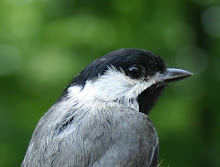Deanna at Adventure Farm brought several flats of heirloom tomatoes to work on Tuesday. She told me she was trying to give them away, otherwise they were going into the compost bin. I decided right there on the spot to try my hand at growing tomatoes. Don't you just love my spontaneity? At the moment of my decision, I had no previous experience with tomatoes (other than eating them), nor did I research how to grow tomatoes. I just had a vague recollection that you were suppose to stake the tomatoes and where in the hardware store to find those stakes.
Deanna filled me in on the various species of tomatoes and which plants were determinate (bushy and producing only one set of fruit) or indeterminate (vine and producing fruit throughout the summer). She told me it was possible to grow tomatoes in containers and advised me to stake them fairly soon.
Stream Girl's mother was also present at my impromptu decision and successfully fielded my line of questioning on growing this vegetable that is really a fruit. She told me not to use twine or any other type of hard string because it would probably cut into and damage the stems and said most hardware stores offered a cloth type of string to tie the growing plants. She also suggested that instead of transplanting the young plants in the usual upright position, I should transplant the plant lengthwise and that portion of the stem covered with soil would develop additional roots. She reassured me the plant would straighten as it grew.
I finally got around to bringing the tomatoes home today.
I was so worried about planting them incorrectly that I planted a few horizontally and a few vertically. I've done a little reading since Tuesday and while I think I've got my bases covered, I'm still feeling very insecure. I'm not sure these containers are big enough for the plants. If any of my lurker readers have tips/suggestions please speak up! How big of a container should I use? How many hours of full sun should they receive? How do I know how much water is enough? And does anyone have suggestions on how to keep squirrels and rabbits away from my plants?
There's A Rotting Corpse In The Mansion's Garage
10 hours ago





